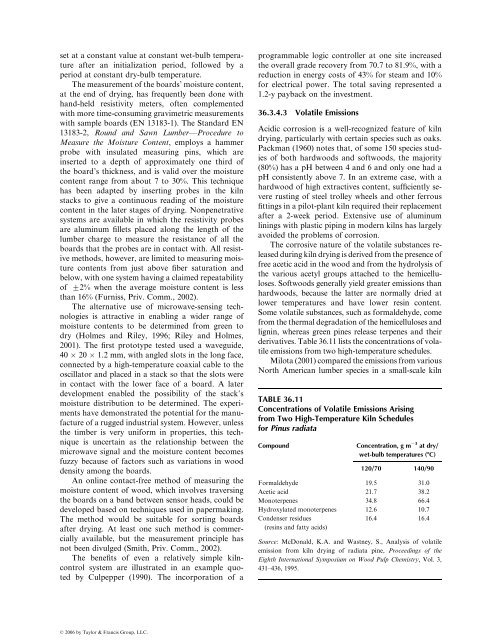36 Drying of Wood
36 Drying of Wood
36 Drying of Wood
- No tags were found...
Create successful ePaper yourself
Turn your PDF publications into a flip-book with our unique Google optimized e-Paper software.
set at a constant value at constant wet-bulb temperatureafter an initialization period, followed by aperiod at constant dry-bulb temperature.The measurement <strong>of</strong> the boards’ moisture content,at the end <strong>of</strong> drying, has frequently been done withhand-held resistivity meters, <strong>of</strong>ten complementedwith more time-consuming gravimetric measurementswith sample boards (EN 13183-1). The Standard EN13183-2, Round and Sawn Lumber—Procedure toMeasure the Moisture Content, employs a hammerprobe with insulated measuring pins, which areinserted to a depth <strong>of</strong> approximately one third <strong>of</strong>the board’s thickness, and is valid over the moisturecontent range from about 7 to 30%. This techniquehas been adapted by inserting probes in the kilnstacks to give a continuous reading <strong>of</strong> the moisturecontent in the later stages <strong>of</strong> drying. Nonpenetrativesystems are available in which the resistivity probesare aluminum fillets placed along the length <strong>of</strong> thelumber charge to measure the resistance <strong>of</strong> all theboards that the probes are in contact with. All resistivemethods, however, are limited to measuring moisturecontents from just above fiber saturation andbelow, with one system having a claimed repeatability<strong>of</strong> +2% when the average moisture content is lessthan 16% (Furniss, Priv. Comm., 2002).The alternative use <strong>of</strong> microwave-sensing technologiesis attractive in enabling a wider range <strong>of</strong>moisture contents to be determined from green todry (Holmes and Riley, 1996; Riley and Holmes,2001). The first prototype tested used a waveguide,40 20 1.2 mm, with angled slots in the long face,connected by a high-temperature coaxial cable to theoscillator and placed in a stack so that the slots werein contact with the lower face <strong>of</strong> a board. A laterdevelopment enabled the possibility <strong>of</strong> the stack’smoisture distribution to be determined. The experimentshave demonstrated the potential for the manufacture<strong>of</strong> a rugged industrial system. However, unlessthe timber is very uniform in properties, this techniqueis uncertain as the relationship between themicrowave signal and the moisture content becomesfuzzy because <strong>of</strong> factors such as variations in wooddensity among the boards.An online contact-free method <strong>of</strong> measuring themoisture content <strong>of</strong> wood, which involves traversingthe boards on a band between sensor heads, could bedeveloped based on techniques used in papermaking.The method would be suitable for sorting boardsafter drying. At least one such method is commerciallyavailable, but the measurement principle hasnot been divulged (Smith, Priv. Comm., 2002).The benefits <strong>of</strong> even a relatively simple kilncontrolsystem are illustrated in an example quotedby Culpepper (1990). The incorporation <strong>of</strong> aprogrammable logic controller at one site increasedthe overall grade recovery from 70.7 to 81.9%, with areduction in energy costs <strong>of</strong> 43% for steam and 10%for electrical power. The total saving represented a1.2-y payback on the investment.<strong>36</strong>.3.4.3 Volatile EmissionsAcidic corrosion is a well-recognized feature <strong>of</strong> kilndrying, particularly with certain species such as oaks.Packman (1960) notes that, <strong>of</strong> some 150 species studies<strong>of</strong> both hardwoods and s<strong>of</strong>twoods, the majority(80%) has a pH between 4 and 6 and only one had apH consistently above 7. In an extreme case, with ahardwood <strong>of</strong> high extractives content, sufficiently severerusting <strong>of</strong> steel trolley wheels and other ferrousfittings in a pilot-plant kiln required their replacementafter a 2-week period. Extensive use <strong>of</strong> aluminumlinings with plastic piping in modern kilns has largelyavoided the problems <strong>of</strong> corrosion.The corrosive nature <strong>of</strong> the volatile substances releasedduring kiln drying is derived from the presence <strong>of</strong>free acetic acid in the wood and from the hydrolysis <strong>of</strong>the various acetyl groups attached to the hemicelluloses.S<strong>of</strong>twoods generally yield greater emissions thanhardwoods, because the latter are normally dried atlower temperatures and have lower resin content.Some volatile substances, such as formaldehyde, comefrom the thermal degradation <strong>of</strong> the hemicelluloses andlignin, whereas green pines release terpenes and theirderivatives. Table <strong>36</strong>.11 lists the concentrations <strong>of</strong> volatileemissions from two high-temperature schedules.Milota (2001) compared the emissions from variousNorth American lumber species in a small-scale kilnTABLE <strong>36</strong>.11Concentrations <strong>of</strong> Volatile Emissions Arisingfrom Two High-Temperature Kiln Schedulesfor Pinus radiataCompoundConcentration, g m 3 at dry/wet-bulb temperatures (8C)120/70 140/90Formaldehyde 19.5 31.0Acetic acid 21.7 38.2Monoterpenes 34.8 66.4Hydroxylated monoterpenes 12.6 10.7Condenser residues(resins and fatty acids)16.4 16.4Source: McDonald, K.A. and Wastney, S., Analysis <strong>of</strong> volatileemission from kiln drying <strong>of</strong> radiata pine, Proceedings <strong>of</strong> theEighth International Symposium on <strong>Wood</strong> Pulp Chemistry, Vol. 3,431–4<strong>36</strong>, 1995.ß 2006 by Taylor & Francis Group, LLC.
















